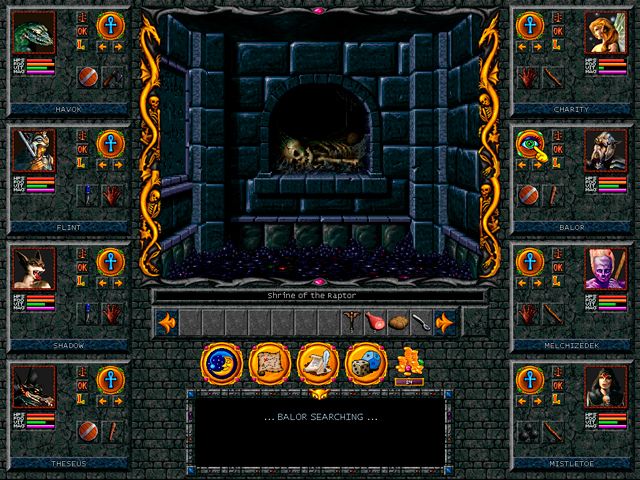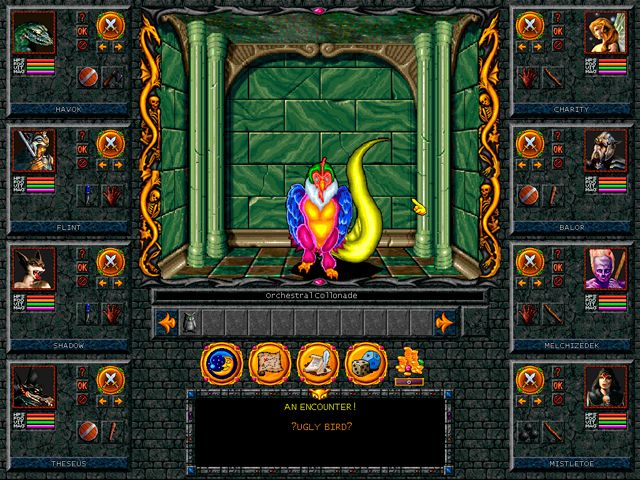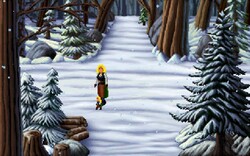RPG Codex Interview: Grimoire: Heralds of the Winged Exemplar
RPG Codex Interview: Grimoire: Heralds of the Winged Exemplar
Interview - posted by Zed on Sun 28 October 2012, 15:42:40
Tags: Cleveland Mark Blakemore; Grimoire: Heralds of the Winged Exemplar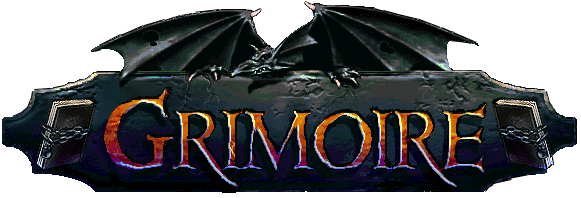
Grimoire: Heralds of the Winged Exemplar is scheduled for released in May 2013. Even with tangible proof of its existence (in the form of an old beta floating around the internet and a dozen of gameplay videos on YouTube), there are still people who disbelieve it. Some even doubt the game's very existence. They see Grimoire as a hoax - a dreamy knockback to the golden age of dungeon-crawling never to be experienced by any living soul. You see, the game has been in development for over 17 years. It started in the mid 90s, during the true dawn of the information age. To put it in perspective, here are some of the events that have happened since:
Dolly the Sheep was cloned. Princess Diana died. Windows 95, 98, ME, 2000, XP, 7 and 8 were released. iMac. The Lewinsky Scandal. The Millennial Shift. All the presidential terms of Bush, and the first of Obama. The introduction of the euro currency (€). The decline of the euro currency. 9/11. Michael Jackson's child molestations and, much later, death. The 2004 tsunamis. Hurricane Katrina. All that shit in the middle-east.
Needless to say, a lot of things have happened over the years. While Grimoire was in development, we saw another rise of CRPGs in the late 1990s, and later the decline. Perhaps we might see Grimoire take its place in history as part of the mid-2010's incline of CRPGs, in between the end of the world and the second coming of Jesus Christ to Earth?
The game's primary developer, a man living in Australia by the name of Cleveland Mark Blakemore, has a reputation to match the remarkable title he is working on. A legend of the RPG Codex and other CRPG internet-bastions, Cleve has over the years shared many of his exploits. Not only as a developer of RPGs but also as a life-adventuring alpha male of near supernatural powers.
However, in this interview, we will focus on Grimoire. The game has recently been put up on indiegogo, with Cleve looking for funds to enhance it before the May 2013 release.
•●• ▬▬▬▬▬▬▬▬▬▬ •●•
What can you tell us about Hyperborea, the world the player explores in Grimoire? What sort of environments are there to traverse, and what manners of creatures inhabit them? What served as your greatest inspirations when crafting the world and its lore?
Hyperborea is based on the many disparate writings of Greeks and other archivists, from Pliny to Virgil, Pindar, Simonides, Hellanicus and several others. All of these men described this place alongside other accounts of geographic regions that we know are real. Nobody has ever fully understood exactly why Hyperborea was written of so earnestly when all the evidence indicates it was a mythical place. One of the things all the writers were agreed on was that Hyperborea was somewhere on earth but a difficult place to reach, almost requiring some sort of spiritual transformation to arrive in.
Hyperborea was commonly envisioned as a place where there was no sorrow. I began to think about the implications of a place that is perfectly serene and content all the time. Without some conflict, how would any progress occur? Then I imagined I was in charge of Hyperborea and I have been tasked to keep it intact. Would I make the mistake of thinking introducing a bit of trouble might actually be part of my job? Based on this initial premise, the entire story unfolded for me quite rapidly very early on. A recurrent theme present in my ideas about the world from a young age is the notion that humans often try to fix a world that isn’t broken and doesn’t need any intervention by them. In doing so they always manage to make things much worse, even intolerable and they don’t know how to recover what they didn’t appreciate they had. I have always believed that humans often have just enough brains to get themselves into dire straits they do not correspondingly have the brains to get themselves out of. This cycle is repeated in history until it is the rule, not the exception. Why shouldn’t the same mistakes be made in the mythical land of Hyperborea?
I have drawn on a broad assortment of legendary creatures and fantastic writings to populate this world from thousands of different sources. I have modeled characters in the game after figures from Rudyard Kipling, Ambrose Bierce, Kafka and Emily Dickinson. I have a rich interior and I didn’t cultivate it to impress girls. It is the result of hundreds of thousands of hours of reading, including the Western pantheon and all the other books they tell us are not worth reading anymore. I have a peculiar fondness for Cervantes' anti-hero Don Quixote and he appears in the game as a knight errant.
Hyperborea was commonly envisioned as a place where there was no sorrow. I began to think about the implications of a place that is perfectly serene and content all the time. Without some conflict, how would any progress occur? Then I imagined I was in charge of Hyperborea and I have been tasked to keep it intact. Would I make the mistake of thinking introducing a bit of trouble might actually be part of my job? Based on this initial premise, the entire story unfolded for me quite rapidly very early on. A recurrent theme present in my ideas about the world from a young age is the notion that humans often try to fix a world that isn’t broken and doesn’t need any intervention by them. In doing so they always manage to make things much worse, even intolerable and they don’t know how to recover what they didn’t appreciate they had. I have always believed that humans often have just enough brains to get themselves into dire straits they do not correspondingly have the brains to get themselves out of. This cycle is repeated in history until it is the rule, not the exception. Why shouldn’t the same mistakes be made in the mythical land of Hyperborea?
I have drawn on a broad assortment of legendary creatures and fantastic writings to populate this world from thousands of different sources. I have modeled characters in the game after figures from Rudyard Kipling, Ambrose Bierce, Kafka and Emily Dickinson. I have a rich interior and I didn’t cultivate it to impress girls. It is the result of hundreds of thousands of hours of reading, including the Western pantheon and all the other books they tell us are not worth reading anymore. I have a peculiar fondness for Cervantes' anti-hero Don Quixote and he appears in the game as a knight errant.
For Grimoire, you take inspiration from Wizardry 6 and 7, but not Wizardry 8. What makes the former superior to the latter, in your view?
Wizardry 8 is a derivative work attempting to copy the superficial mechanics of the earlier two games. I believe it is soulless and empty compared to Bane of the Cosmic Forge and Crusaders of the Dark Savant. There is more atmosphere in the first city you enter in Wiz 7 than the entire game in Wizardry 8. An honest appraisal would conclude that the primitive 3D in Wizardry 8 is manifestly inferior to the hand crafted artwork of W6-W7 for atmosphere and immersion. The graphics in Wizardry 8 were not good 3D environments and they weren’t much for classic dungeon blobbers. Lands of Lore was infinitely superior and they made the same mistake, moving from a beautiful handcrafted appearance in the first game to a sterile, flat and unconvincing 3D engine with flat billboarded sprites in the sequel. I thought the first Lands of Lore looked like a Richard Corben graphic novel from beginning to end.
Wizardry 8 was what flowed into the vacuum left behind by David Bradley and Anthony Greenberg at Sir-Tech. It was the absence of the good, which is the worse thing you can be as far as I am concerned. The absence of the good is worse than merely bad.
Wizardry 8 was what flowed into the vacuum left behind by David Bradley and Anthony Greenberg at Sir-Tech. It was the absence of the good, which is the worse thing you can be as far as I am concerned. The absence of the good is worse than merely bad.
Tell us about classes in Grimoire and the class changing mechanics. Are there classes that you cannot select during character creation, or that require very high attributes like in Wizardry? If so, do these advanced classes overtake the basic ones like in Wizardry, or do the latter remain useful throughout the game?
I am making all classes accessible during character creation in response to feedback from previous beta testers. I am still balancing gameplay against the classes and I think this will take the better part of the next few months to get adjusted as well as Wizardry 7.
The advanced character classes like Jester and Templar develop abilities as they progress that are much more impressive than those of other classes but of course require more experience points to move to the next level and they will require far better bonuses during character creation.
The advanced character classes like Jester and Templar develop abilities as they progress that are much more impressive than those of other classes but of course require more experience points to move to the next level and they will require far better bonuses during character creation.

A small selection of sprites from Grimoire: Heralds of the Winged Exemplar.
In general, as far as character development is concerned, how much does Grimoire have in common with Wizardry 6 and 7, and in what ways does it differ?
Both games feature elite classes. I would have liked to bring in dual classes and it is possible this may still appear in the sequel. All the character classes are intended to develop in unique directions during the course of the game that makes those classes worthwhile to have in the party.
At level 10, class switching with penalties becomes available but advancement is more rapid early on for those new classes. I think that I have done a good job of balancing these career changes with certain drawbacks so as to make it less than convenient and as challenging as starting out with that profession.
At level 10, class switching with penalties becomes available but advancement is more rapid early on for those new classes. I think that I have done a good job of balancing these career changes with certain drawbacks so as to make it less than convenient and as challenging as starting out with that profession.
The pitch video for the Indiegogo campaign has a thaumaturgist create a new ingredient through some kind of alchemical process, and also mentions enchanting. Could you describe these systems in some detail?
Thaumaturges are intended to be the master alchemists of the game, Metalsmiths the best weapon manufacturers and Assassins the best poisoners. Some merges in the game require particularly advanced skill levels to achieve and can result in items that might otherwise never be found. The Templar can enchant a weapon so that it has an aura that makes it capable of hitting magic creatures and giving better results until it wears off. In addition to the special inherent power of turning undead, the Templar can prepare the party for a big battle in this fashion against a creature that can only be harmed by magic weapons.
Another example of item manipulation in the video is combining a crab with a shell. It is mentioned that these combinations may not be always quest related. Just how many item types are there in Grimoire, and what are the things the player can do with them? Will we be able to experiment with combining items outside of alchemy?
Yes, simple merges that have no skill requirements can be achieved in the main window. Complex merges requiring certain skills are best accomplished in the “Item Workshop.”
One of the improvements in coming months will be building a grid editor for the merges that will provide a very powerful overview of what certain classes can merge and how. At present this data is in the item editor and part of moving it into it’s own editing system is essential to establishing the merge combinations in the game and the charts printed in the solution manual.
One of the improvements in coming months will be building a grid editor for the merges that will provide a very powerful overview of what certain classes can merge and how. At present this data is in the item editor and part of moving it into it’s own editing system is essential to establishing the merge combinations in the game and the charts printed in the solution manual.
Earlier you showed us a video of the lockpicking process in action. Can you tell us more about the thief's role outside of combat? Apart from picking locks and spotting traps, do thieves have other abilities such as stealing or hiding in the shadows?
Thieves can pick locks on chests and doors, hide in the shadows and backstab, steal items from NPCs and apply poisons to weapons for combat. I have tried as much as possible to make a thief a nearly essential member of a well balanced party. It is possible to try to slide by with a wizard casting KNOCK-KNOCK spells but I have tried to balance it out so the thief still brings valuable skills that contribute substantially to success by the party.
How do you approach puzzle design in Grimoire? How unique and how difficult do you want the puzzles to be?
I have tried to make as many puzzles as possible solvable in multiple ways. I have succeeded in many cases but there are still doors unlocked by only one key and many other puzzles in the game that require a specific solution. I never want any puzzle to be so frustrating it discourages the player from continuing. I have a fondness for “discovery” in which the player wanders around diligently and suddenly stumbles over a situation or an item that reminds them of a puzzle they walked away from. I like it when things emerge out of the apparent chaos and begin to structure themselves into a narrative. A good example of this would be the Cenotaph of the Black Lich, where a lot of different tales we may have heard start to coalesce into further developments of the storyline. The Cenotaph is the key to gaining access to the lower levels of Samhain as well as the Black Lich himself.
Grimoire has been in development for over 17 years. Have you stayed true to a singular vision throughout these years, or has it been altered in any way?
I imagined it this way at the outset and hoped it would turn out pretty much the way it has ended up. Sir-Tech would have never let me make this game. They would have had ten mediocre cooks spoiling this broth and it would taste so foul when it was finished nobody could stomach it. This game ended up being pure Cleve Blakemore from start to finish and when people play this game they will have a good idea of what is meant by “pure Cleve Blakemore.” There is plenty of absurdity in the game, lots of humor and the whole thing is meant to be good fun right up to the very end. I mix moments of cosmic horror with abject ridiculousness, terrifying revelations alongside baffling irreverence and some stuff that just never does make any logical sense, the same way I write on the internet. Like it or leave it this is my product and I am proud of it. If you don’t enjoy it then it is likely that you just don’t enjoy my kind of game.
During all this time of development and iteration, what has been the most challenging and time-consuming task? Has there ever been a time when you felt like abandoning Grimoire for good?
Finishing off the features I injected while working on it. Obviously, there has been a problem with feature creep, scope and ambitiousness for a one man project.
I would never abandon Grimoire. There were months in the past decade I was so disgusted with it I could not bear to touch it for weeks at a time but I always rebounded from these lapses and resumed my infernal meddling. I knew after the first two years I had designed my way into a monster. What had been simple to plan out at the start turned out to be the labors of Hercules in the implementation for one person. We are talking about mountains of work that would likely have been very tough for a single guy assigned just one aspect like the game editors. If you start to imagine me doing that guy’s job as well as that of ten other people working on the game and then you imagine that game being fifty times bigger than any other game you will start to see the size of it.
I would never abandon Grimoire. There were months in the past decade I was so disgusted with it I could not bear to touch it for weeks at a time but I always rebounded from these lapses and resumed my infernal meddling. I knew after the first two years I had designed my way into a monster. What had been simple to plan out at the start turned out to be the labors of Hercules in the implementation for one person. We are talking about mountains of work that would likely have been very tough for a single guy assigned just one aspect like the game editors. If you start to imagine me doing that guy’s job as well as that of ten other people working on the game and then you imagine that game being fifty times bigger than any other game you will start to see the size of it.
For your Indiegogo campaign, you have set the funding goal at $250,000. Can you break down this goal for us? How did you come up with it, and why this particular sum?
I figure this is what I spent out of my own pocket over the past 17 years on contract work like the art, sound and music and if I recover that much before it ships then I will start out neutral when it launches. That’s a good scenario for me and I thought it was a fair goal to aim for.
Thanks to Indiegogo's flexible funding scheme, you will receive all the money pledged even if the $250,000 goal is not met. However, you state that no matter the campaign's result, you are determined to ship the game in May 2013. What are the features you will prioritize if the campaign falls short, and how will you allocate the money?
The primary feature if funding falls short will be completing the game.
The first thing I will fund if the money is there is new music and sound effects aimed at modern audio equipment. I love the MIDI and 8 bit sound effects but solid MP3 and 16 bit stereo sound would be a terrific development before it goes out. I will keep the option to switch to the original sound and music as an option in the configuration. I’d also like some voiceover work for the NPCs in several places just to enhance their primary dialogue.
New UI graphics and animated cutscenes for many different events in the game would be a close second but obviously if they don’t make it in there, it is not like these are things you can’t live without.
With or without making the goal, there is an awful lot of artwork standing by that I have paid for to be incorporated into the game that Grimoire fans have never seen. It is going to be a new game when it ships for certain.
The first thing I will fund if the money is there is new music and sound effects aimed at modern audio equipment. I love the MIDI and 8 bit sound effects but solid MP3 and 16 bit stereo sound would be a terrific development before it goes out. I will keep the option to switch to the original sound and music as an option in the configuration. I’d also like some voiceover work for the NPCs in several places just to enhance their primary dialogue.
New UI graphics and animated cutscenes for many different events in the game would be a close second but obviously if they don’t make it in there, it is not like these are things you can’t live without.
With or without making the goal, there is an awful lot of artwork standing by that I have paid for to be incorporated into the game that Grimoire fans have never seen. It is going to be a new game when it ships for certain.
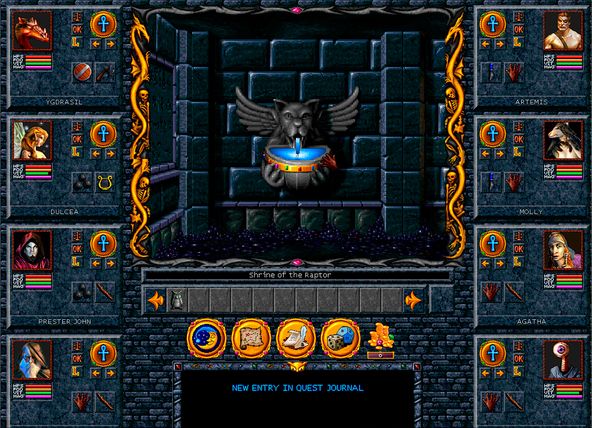
An earlier screenshots from the indiegogo gallery.
In your Indiegogo pitch, you speak of your perfectionist trait that you ascribe to your "Neanderthal genes". Do you see this kind of perfectionism as a threat to the target release date of May 2013? How do you make sure the game does not end up being delayed again? And most importantly, how would you convince people that it is for real this time?
If you get a chance, ask your scienmagists about the lovingly drawn ‘thal cave paintings of the spotted horses. Ask them how wild horses could have those spots when that is a recessive trait specifically associated with domestication. Horses with spots are night blind which is a great trait if you are in a stable after sundown. Ask your scienmagists, tell them your crazy Neanderthal buddy is an inquiring mind and the rodeo clown wants to know. I reckon the spotted horse alone blows apart 400 years of Sapiens scienmajistics in five seconds. Stupid Enkidu, always peeing in the scienmajistic punch bowl.
No new features. No improvisational ideas. No added work. In several places, I have cut the Gordian Knot and just made it work. The miniquests had been this nightmarish complexity for a while with three game editors involved. I slashed all that a couple weeks ago and had miniquests working in ten minutes in a far more simplified form.
I think most reasonable people would realize that after a long acquiescence the game has entered a phase now where the target has become clarified and bounded by a deadline to simply complete it and ship it. I am certain the people pledging have realized this may be a long bet with a pretty big payoff if they end up with exclusive copies of physical media for one of the biggest vaporware RPGs in human history that we know of at this time.
No new features. No improvisational ideas. No added work. In several places, I have cut the Gordian Knot and just made it work. The miniquests had been this nightmarish complexity for a while with three game editors involved. I slashed all that a couple weeks ago and had miniquests working in ten minutes in a far more simplified form.
I think most reasonable people would realize that after a long acquiescence the game has entered a phase now where the target has become clarified and bounded by a deadline to simply complete it and ship it. I am certain the people pledging have realized this may be a long bet with a pretty big payoff if they end up with exclusive copies of physical media for one of the biggest vaporware RPGs in human history that we know of at this time.
Do you have any plans to release a trial or demo version of the game? If you do, then at what point?
I will be releasing a demo of the basic starter region with four maps before end of December, possibly at the end of November. Right now the biggest hurdle has been adapting to the new resolution of 1024x768, our first goal on IndieGoGo which we achieved. This demo will be public and should end anyone’s doubts the game exists for good.
On the Indiegogo page you promise to start working on a sequel immediately after Grimoire's release. What do you have in mind for the sequel, and how different do you want it to be from the original game? Are there any features that you cannot implement in Grimoire for whatever reason, but would like to introduce in the sequel?
All I know for certain about the sequel is that it will be in high color and it will be an absolutely awesome finish to the story that begins in the first game. I was originally planning a trilogy 17 years ago but the truth is, the story will be complete in the sequel. The sequel will be about the universe’s worst troublemakers, do-gooders and multi-level marketers at “Reality Hijinx.”

Heralds of the Winged Exemplar is the subtitle of the first Grimoire game. There were plans for a trilogy, but now Cleve is planning to end the story with the sequel.
You claim to have worked on Wizardry: Stones of Arnhem, a sequel to Wizardry 7 that never saw the light of day. Was it your first experience working on a CRPG? What did you do prior to Arnhem? Did you ever dabble in pen and paper games?
I published several roleplaying games with topdown perspective for the Commodore 64 before I worked for Sir-Tech. I wrote a couple hundred games for the C-64 and the Amiga published commercially, in print and digital magazines and in discount brand software distributor lines. Most people who owned C-64s played a game by me at some point. If you look up “old skool” in the dictionary, you will see they have a little photo of me beside the definition. I am one of those hackers that everybody seems to recall at some point who labored in the margins of the industry forever content to do nothing but write games. Twice I was offered jobs by corporate game companies who offered to make me respectable and I never came in out of the cold. I was happy just the way I was. The only reason I took the job with Sir-Tech was the potential to establish myself with a classic title. It certainly wasn’t the money. It was never money for me. That probably makes me a born loser ... or as we Neanderthals say, “The good son, Abel.” Never Cain.
I ran campaigns for friends in Dungeons and Dragons for many years and enjoyed crafting storylines for them immensely, including science fiction and cyberpunk narratives. Many characters from these pen-and-paper campaigns ended up in Grimoire.
I ran campaigns for friends in Dungeons and Dragons for many years and enjoyed crafting storylines for them immensely, including science fiction and cyberpunk narratives. Many characters from these pen-and-paper campaigns ended up in Grimoire.
You have talked about it on our forums, but for the sake of this interview can you tell our readers a little about Wizardry: Stones of Arnhem? When and how did the project originate, what was your role on it, and why was the game never released?
I wrote in great detail about it in the now-apocryphal thread “Why Did Sir-Tech Go Bankrupt?” (Editor's note: link to the thread) If Sir-Tech had not been such pitiful managers it is possible that Grimoire would have never existed. I am sure in that alternate universe we completed the game and it was certainly respectable but let’s face it - it would not be Grimoire. And Grimoire is the Maximum Win of Great Justice. It’s true, the Lord does work in mysterious ways.
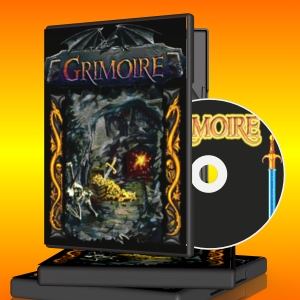
The Grimoire physical box, as envisioned by Cleve on indiegogo.
You mention a Michael "Shams" Shamgar in the pitch video. You say he also worked on Wizardry: Stones of Arnhem. What is his role working on Grimoire, and what has he contributed?
If I had not worked for Sir-Tech on “Stones of Arnhem,” I would have never met Shams. Shams has been indispensable with his work on the Kingstep engine and assisting with many of the finer technical details of the game. I hope that I work with Shams in the future on other projects but let’s face it, the guy is ten kinds of awesome as a systems programmer and general developer. In case you have not guessed yet, Shams is the Dean Martin half of the team. Guess which half I am.
Do you often go back and play classic party-based first-person CRPGs? What do you think makes these games special? Which one is your favorite (besides Grimoire) and why?
I keep a game running all the time of Bane of the Cosmic Forge. I find it is essential to see what works for a turn-based game. I just completed Eye of the Beholder II for the 9th time. That game never gets old and it gets better every time I play it. I have played Lands of Lore through to the end three times and would like to try it again. These games are canon. You cannot understand what constitutes quality game design until you understand what makes these games great. The problem with modern games is the generation creating them. They just are not as good as the games of the Golden Era and they never will be. There are exceptions. My son has been telling me I need to play Arkham Asylum and I am going to set aside some time to do so. He plays everything and is pretty much in agreement with me that most all of it is dreck. We were talking the other day about how wonderful the original Yoshi was as a platform game on the Nintendo 64. We have not seen it’s like since.
When you see the crowds guffawing at “Horse” getting hit in the testicles on America’s Got Talent, you could guess that this generation as a rule is not going to be producing great art and culture. It’s about the decline. Grimoire is about incline, plain and simple. It’s about monocles and lifting standards.
My ambition has always been to make a game of equal calibre that it could stand alongside the greats. I suppose we will find out if I succeeded in May 2013.
When you see the crowds guffawing at “Horse” getting hit in the testicles on America’s Got Talent, you could guess that this generation as a rule is not going to be producing great art and culture. It’s about the decline. Grimoire is about incline, plain and simple. It’s about monocles and lifting standards.
My ambition has always been to make a game of equal calibre that it could stand alongside the greats. I suppose we will find out if I succeeded in May 2013.
•●• ▬▬▬▬▬▬▬▬▬▬ •●•
We thank Cleve Blakemore for taking the time to answer our questions. Again, here is a link to the indiegogo campaign, here is a link to Cleve's Golden Era Games website, and here is a link to the "The Grim Blog" (a somewhat whimsical development blog).
Hugs and kisses to Alex, Crooked Bee and Phelot for their help with the interview!
There are 94 comments on RPG Codex Interview: Grimoire: Heralds of the Winged Exemplar




